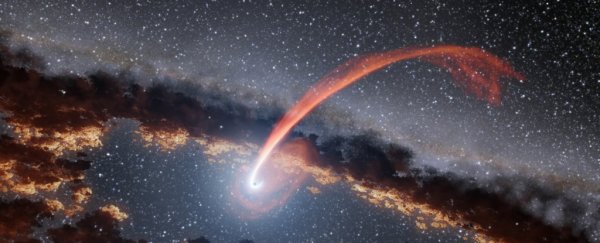For all our perception of supermassive black holes as gravitational vortices ravenously devouring stars, it doesn't actually happen that often. For instance, our galaxy's own black hole might only do it a handful of times every 100,000 years.
So it's quite a special occasion for the astronomers who have just observed the immediate aftermath of this devouring event. In fact, this new observation is the earliest we've ever seen it happen.
This means we could observe it with multiple telescopes. In turn, those observations have delivered a tremendous wealth of data that can help to refine our understanding of how supermassive black holes gobble up stars - what are known as tidal disruption events (TDEs).
This particular TDE occurred around a supermassive black hole 6.3 million times the mass of the Sun (our own Milky Way's Sagittarius A* is 4 million solar masses), in a galaxy called 2MASX J07001137-6602251, roughly 375 million light-years away.
(Standard disclaimer - what we're seeing actually happened 375 million years ago, but the light is only reaching us now, so we refer to the events as occurring when we experienced them.)
And it just so happened that this TDE occurred in the tiny patch of sky being continuously watched by NASA's planet-hunting telescope TESS. And the All-Sky Automated Survey for Supernovae (ASAS-SN) is monitoring the same part of the sky that TESS surveys.
When astronomers noticed something in the ASAS-SN data growing brighter on 29 January, they sprung into action to turn a number of telescopes towards 2MASX J07001137-6602251.
It then turned out that, because TESS had been monitoring the same part of the sky, it had data tracking back eight days earlier.
Sure enough, the supermassive black hole had caught a star, with intense gravity pulling the star apart. The team has not yet determined the mass of the victim, but the event was so energetic it produced a light peak over 10 orders of magnitude brighter than the Sun - and four times brighter than its host galaxy.
And, spectacularly, a team of astronomers got to watch that peak build from the earliest moment when we could have even detected the event.
"This is the earliest we've ever seen emission from a TDE, and the earliest we could possibly see it - because TESS was already monitoring the part of the sky where it happened, we got to see exactly when it started to get brighter," astronomer Tom Holoien of Carnegie Science told ScienceAlert.
"There are only about 4 or 5 TDEs that are published that have been found prior to peak at all, and none were as early as this."
The event - named ASASSN-19bt - was first detected by TESS on 29 January 2019. Because it seemed to come from the central region of the host galaxy, a closer look was warranted. On 31 January, the team studied the region using the Low-Dispersion Survey Spectrograph 3 (LDSS-3), mounted on the Magellan Clay telescope in Chile.
This revealed that the event was likely a TDE, and more observations were taken; the NASA Swift Observatory imaged the event in ultraviolet and X-rays; the ESA XMM-Newton took spectra; and ground-based telescopes at Las Cumbres Observatory took optical images.
ASASSN-19bt reached peak brightness on 4 March 2019, and the team continued to observe the event months after (although their paper only covers until 10 April).
And there were some big surprises.
"NASA's Swift satellite .. indicated that for the first few days after discovery the TDE actually got fainter and cooled down considerably. This has never been seen before - typically before it reaches its maximum brightness we would see the brightness rise steadily, and the temperature typically remains constant," Holoien said
"In this case, we see both the brightness and temperature drop sharply before it follows the usual evolution that we've seen before. This also could be a common feature in TDEs, but we just don't know, because no TDE has had Swift data this early."
In addition, the host galaxy is younger and dustier than other galaxies in which such events have been observed. And, as the TDE brightened towards peak, the increase in luminosity was very smooth. This is something else that hadn't been seen before.
At the very earliest part of the observations, the emissions are coming from extraordinarily close to the black hole, Holoien told ScienceAlert - maybe a few tens of times the size of the event horizon, as close to the black hole as Mars or Earth is to the Sun.
When you remember how far that galaxy is, that's pretty extraordinary.
"I actually got chills when I saw the TESS light curve for the first time, because no TDE has been observed anywhere close to as early, or on as rapid a cadence," he said. "When I saw it, I said we had to write this paper ASAP, because this was going to be an amazing dataset - and then we found the other interesting aspects too!"
The team continued to monitor ASASSN-19bt for three months following the peak, and will be publishing their results in a separate paper. It will mark the most complete and comprehensive dataset ever published for a tidal disruption event.
Meanwhile, fingers remain crossed that TESS will get this lucky again, so that scientists will have a separate dataset for comparison.
"These observations are so early that while they're generally in-line with the physical models, none of the theory had exactly predicted what we see, so these observations will hopefully help us refine those models," Holoien said.
The research has been published in The Astrophysical Journal.
